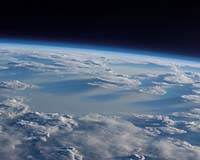| . |  |
. |
Paris (AFP) Sept 6, 2009 Climate change will disrupt Earth's precious ozone layer, boosting ultraviolet (UV) radiation in the deep southern hemisphere and reducing UV in far northern latitudes, a study warned on Sunday. By century's end, UV levels in Antarctica could rise by up to 20 percent at seasonal peaks while average exposure in northern Scandinavia, Siberia and northern Canada could fall by almost a tenth. The shift could have worrying impacts on human health, as high exposure to UV is linked to cancer, cataracts and crop damage just as low exposure causes vitamin D insufficiency. "Our study is showing that there is a new threat to the ozone layer, and this is climate change, which will either increase or decrease UV depending on the region," said atmospheric physicist Michaela Hegglin of Canada's University of Toronto. "And while too much UV exposure is known to be a bad thing, too little UV exposure can also have detrimental effects, though these are much less explored." The ozone layer refers to the thin sandwich of triple-atom oxygen molecules in the stratosphere, between 10 and 50 kilometers (six and 30 miles) in altitude, which filter harmful UVB light from the Sun. Awareness of the layer's importance emerged in the 1970s, when scientists discovered it was being depleted by chlorofluorocarbon (CFC) chemicals used in aerosols and refrigeration. An international treaty, the Montreal Protocol, set down measures to phase out these chemicals, and the ozone "hole" over Antarctica caused by CFCs is expected to recover by the latter half of the century. The new study, published in the journal Nature Geoscience, points to an unforeseen peril -- not from depletion but from the way the ozone layer is distributed by high-altitude winds. Hegglin and co-author Theodore Shepherd put together a computer model simulating the consequences of warmer surface temperatures on an atmospheric pump called the Brewer-Dobson circulation, which drives ozone around the world. Under it, air is moved upwards from the tropics -- where most ozone is produced -- and then shifts polewards before descending to the lower part of the stratosphere. There it lingers for a long time before eventually entering the troposphere, the lower part of the atmosphere that includes ground level. The computer model suggests that between 1965 and 2095, changes in convention mean the flow of ozone from the stratosphere to the troposphere will rise by 23 percent. The figure is derived from a modest increase in carbon emissions in a scenario also used by the UN's Intergovernmental Panel on Climate Change (IPCC) computer models. It also incorporates the trend towards ozone recovery after CFCs are withdrawn. The shifting layer leads to big changes in UV exposure for those living at Earth's extremities. Above 60 degrees latitude north, a line roughly giving the location of Stockholm, Helsinki, Saint Petersburg and Anchorage, Alaska, clear-sky levels of UV will fall by 9.1 percent by 2095 compared with 1965 levels. In the northern mid-latitudes, there will be a fall of 3.6 percent. In the tropics, UV exposure will rise by 3.8 percent. The southern mid-latitudes will be unchanged. Below 60 degrees latitude south -- essentially Antarctica -- there will be a UV increase of an average 3.2 percent, although this figure masks huge swings. In the southern hemisphere's late spring and early summer, UV levels in Antarctica could rise by up to 20 percent, equivalent to nearly half of the ozone hole caused by CFCs. Another concern is that a rise in ozone levels in the troposphere could have an effect on air quality and stoke the warming cycle. Ozone in the troposphere becomes both a greenhouse gas and a potential health problem. At ground level, ozone formed by the reaction between sunlight and road pollution is a notorious irritant for people with respiratory problems. Share This Article With Planet Earth
Related Links All about the Ozone Layer
 Nitrous oxide is top destroyer of ozone layer: study
Nitrous oxide is top destroyer of ozone layer: studyWashington (AFP) Aug 31, 2009 Nitrous oxide emissions caused by human activity have become the largest contributor to ozone depletion and are likely to remain so for the rest of the 21st century, a US study has concluded. The study by the National Oceanographic and Atmospheric Agency said efforts to reduce chlorofluorocarbons (CFCs) in the atmosphere over the past two decades were "an environmental success story. ... read more |
|
| The content herein, unless otherwise known to be public domain, are Copyright 1995-2009 - SpaceDaily. AFP and UPI Wire Stories are copyright Agence France-Presse and United Press International. ESA Portal Reports are copyright European Space Agency. All NASA sourced material is public domain. Additional copyrights may apply in whole or part to other bona fide parties. Advertising does not imply endorsement,agreement or approval of any opinions, statements or information provided by SpaceDaily on any Web page published or hosted by SpaceDaily. Privacy Statement |